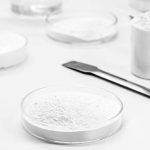The Potential Hydrogen (pH) level of a skincare product refers to its level of acidity or alkalinity. The pH scale ranges from 0 to 14, with 7 being neutral, lower numbers being more acidic, and higher numbers being more alkaline. The pH level of skincare products can affect the skin’s natural pH balance, which is around 4.5 to 5.5, and can impact the effectiveness of the product. In this article, we will discuss the importance of pH levels in skincare products and provide details about the pH levels of common skincare products.
Why does pH Level matter in Skincare Products?
The skin’s natural pH balance is slightly acidic, and this helps to maintain healthy skin. The acid mantle, which is a thin layer on the surface of the skin, helps to protect the skin from bacteria, pollutants, and other irritants. When the skin’s pH balance is disrupted, it can lead to a variety of skin problems, including dryness, irritation, and acne.
Skincare products with a pH level that is too high or too low can disrupt the skin’s pH balance, leading to these problems. For example, using a cleanser with a high pH level can strip away the skin’s natural oils, leading to dryness and irritation. Similarly, using a product with a low pH level can cause irritation and inflammation. The pH level of skincare products is especially important for people with sensitive skin. Sensitive skin is more prone to irritation and inflammation, and using a product with the wrong pH level can exacerbate these problems. Therefore, it is important to choose skincare products with a pH level that is appropriate for your skin type.

pH Levels of Skincare Products
Cleansers
Cleansers are used to remove dirt, oil, and makeup from the skin. They can be either water-based or oil-based, and their pH level can vary depending on the type of cleanser. Water-based cleansers generally have a pH level between 5 and 7, while oil-based cleansers can have a higher pH level, between 7 and 8.
It is important to choose a cleanser with a pH level that is appropriate for your skin type. For example, people with dry skin should use a cleanser with a pH level closer to 5, while people with oily skin can use a cleanser with a slightly higher pH level.
To check the pH level of a cleanser, you can use a pH testing strip, which is available at most pharmacies. Here are the steps to follow:
- Wet your face with warm water and pat it dry with a clean towel.
- Take a pH testing strip and hold it against the cleanser for a few seconds.
- Compare the color of the strip to the chart that comes with the pH testing strips. The color will indicate the pH level of the cleanser.
Toners
Toners are used after cleansing to remove any remaining impurities and to help balance the skin’s pH level. They typically have a pH level between 4 and 6, which helps to restore the skin’s natural acidity.
Toners can also contain ingredients that help to hydrate and soothe the skin, such as aloe vera and hyaluronic acid. These ingredients can help to reduce inflammation and irritation and leave the skin feeling soft and smooth.
To check the pH level of a toner, you can use pH strips or a pH meter:
- Purchase pH strips or a pH meter from a local pharmacy or online retailer.
- Take a small amount of the toner you want to test and put it in a clean container.
- Dip a pH strip into the toner for a few seconds or use the pH meter to measure the pH level directly.
- Compare the color of the pH strip with the color chart provided on the package to determine the pH level of the toner.
- If you are using a pH meter, make sure to adjust it before taking the reading, and follow the instructions provided by the manufacturer.

Moisturizers
Moisturizers are used to hydrate and nourish the skin. They can have a pH level between 4 and 7, depending on the formulation. Moisturizers with a lower pH level tend to be more hydrating and are better suited for people with dry or sensitive skin. Moisturizers with a higher pH level tend to be lighter and are better suited for people with oily or acne-prone skin.
To check the pH level of a natural moisturizer, you will need a pH testing strip or a digital pH meter. Here are the steps to follow:
- Cleanse your skin thoroughly and pat dry with a clean towel.
- Apply a small amount of the natural moisturizer to a clean cotton swab or your fingertips.
- Dab the pH testing strip onto the moisturizer or apply a small amount of moisturizer onto the strip. Alternatively, place the pH meter probe in the moisturizer.
- Wait for a few seconds until the color on the strip stabilizes or the digital meter displays the pH reading.
- Compare the color of the strip with the color chart provided with the strips to determine the pH level of the moisturizer.
Serums
Serums are concentrated treatments that are designed to address specific skin concerns, such as wrinkles, dark spots, and uneven texture. They can have a pH level between 4 and 7, depending on the formulation.
Serums can contain a variety of active ingredients, such as vitamin C, retinol, and glycolic acid. These ingredients can be irritating to some people, especially those with sensitive skin. Therefore, it is important to choose a serum with a normal pH level.
To check the pH level of a natural serum, you will need a pH testing strip or a digital pH meter. Here are the steps to follow:
- Cleanse your skin thoroughly and pat dry with a clean towel.
- Shake the serum bottle well before use.
- Take a small amount of the serum on a clean cotton swab or a dropper.
- Dip the pH testing strip into the serum or apply a small drop of serum onto the strip. Alternatively, place the pH meter probe in the serum.
- Wait for a few seconds until the color on the strip stabilizes or the digital meter displays the pH reading.
- Compare the color of the strip with the color chart provided with the strips to determine the pH level of the serum. Alternatively, read the pH level displayed on the digital meter.
Soaps
Body soap is an essential personal care item used for cleaning the skin and maintaining hygiene. The pH level of body soap is an important factor to consider as it can affect the skin’s pH balance. Traditional soap bars are typically alkaline, with a pH level ranging from 8 to 10. This high pH level can disrupt the skin’s natural pH balance, leading to dryness, irritation, and other skin problems.
On the other hand, natural body soaps are formulated with natural ingredients that are pH balanced and gentle on the skin. They typically have a pH level ranging from 5 to 7, which is closer to the skin’s natural pH level. Natural body soaps are made with essential oils and plant extracts that nourish and moisturize the skin. These soaps when made correctly are also eco-friendly and biodegradable, making them a sustainable choice for personal care. By choosing a natural body soap, you can ensure that your skin stays healthy, hydrated, and nourished.
Here are the steps to check the pH level of natural black soap:
- Purchase a pH testing kit: You can purchase a pH testing kit online or at a local store. The kit should come with pH testing strips or a pH meter.
- Wet the soap: Wet the black soap and lather it in your hands or on a clean surface.
- Test the pH: Take a pH testing strip or meter and dip it into the lathered soap. Make sure the strip or meter absorbs the soap.
- Wait for the results: Wait for the pH strip or meter to indicate the pH level of the soap. The pH level of organic black soap should be between 7-9. A pH level below 7 indicates that the soap is acidic, while a pH level above 9 indicates that the soap is too alkaline.
- Interpret the results: Compare the color of the pH strip to the color chart provided in the pH testing kit. If you are using a pH meter, read the pH level from the display screen.
If the pH level of the soap is outside the recommended range, it may be too alkaline or acidic and may cause skin irritation or other adverse effects. In this case, it is best to avoid using the soap or dilute it with water to adjust the pH level.









Hummm impacting
Thank you 🙏 💕💕